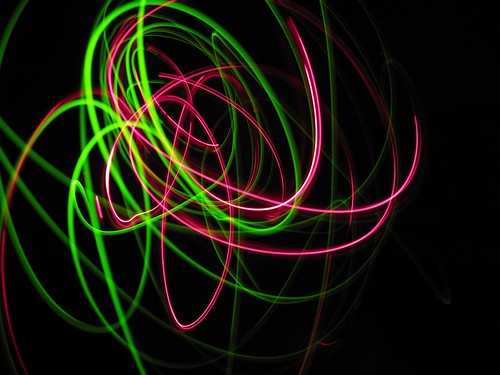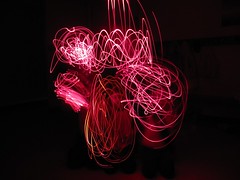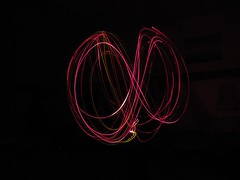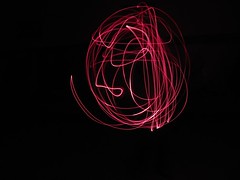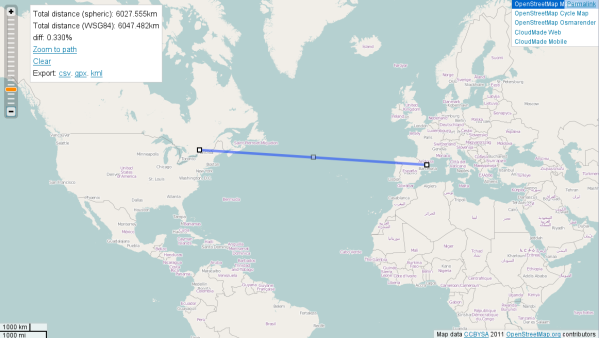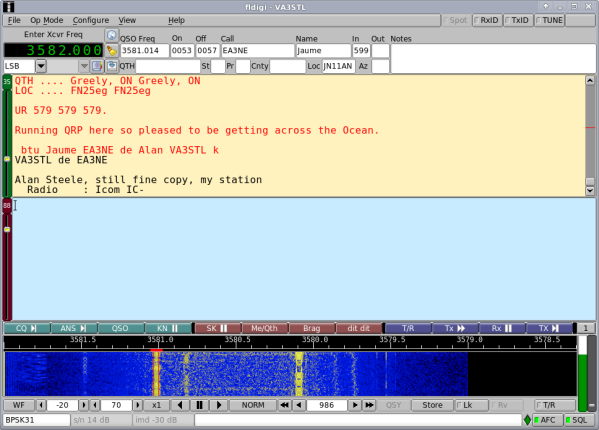Author Archive
 First 12m contact in a long time
First 12m contact in a long time

Grand Cayman (photo by NASA)
On Wednesday I was working from home and took a little time on the K3 during a break. On 15m I heard a strong signal from ZF2UL who was making North American contacts one after the other. Bob, ZF2UL, then said they were going on to the 12m band and gave the frequency they were QSYing to. I followed and continued listening. After a short run of QSOs there was a brief hiatus in the replies to “QRZ?”, at which point I called with my 10W on SSB. I soon obtained a reply and a 55 report and my first contact with Grand Cayman was logged.
Good to see the higher frequency HF bands are opening up more regularly. It has been a long time since I made a contact on 12m.
 Ottawa Amateur Radio Club Presentation
Ottawa Amateur Radio Club Presentation

Just before the start of the OARC meeting (photo copyright of the OARC)
Last week I drove through a snowy evening to give a presentation to the Ottawa Amateur Radio Club (OARC). The meeting was in one of the rooms in City Hall and I have to admit it was my first time attending the OARC.
I was greeted by Dave, VE3TLY, the president and others and it certainly seems to be an active club. There was a report on the club construction project and talk about the upcoming Canadian Ski Marathon and the amateur radio support that is given.
My talk was on D-STAR in the Ottawa Area and started with some D-STAR principles, covered a little on the local repeater VA3ODG and finished off with a look at the current projects and developments. A pdf of the slides are here:> OARC Presentation PDF.
I finished off with a demonstration and tuned the HT to module B of repeater VA3ODG and chatted with a small group that had assembled there. There was some luck as using the repeater with Maurice-Andre, VE3VIG was Greg, VA3OMP, using his FREE STAR* repeater as well as a station connecting in from Florida. This nicely illustrated the linking to the repeater from outside the local area and use of a different (FREE STAR*) network, which I had just earlier mentioned in my talk.
After the demonstration there was some good questions and comments from the audience. The meeting officially wound-up and over coffee I had pleasant discussions with a number of the club members.
A great evening and thanks to the OARC for inviting me and making me so welcome.
 Learning electronics with the aid of the Internet
Learning electronics with the aid of the Internet
You have to learn electronics by building circuits. However, it can be very intimidating to get started and once you have some familiarity you may need further guidance, especially in the art of circuit design. Last week I watched three excellent tutorial videos which show there are some who are putting excellent material on the Web to help others further their learning of electronics. Here are the three.
First video covers some basic, but necessary understanding of multimeters and their use. Essential knowledge for beginners. This is by Colin Cunningham of Makezine.com and part of his ongoing electronics video posts at Make magazine’s website.
The next one steps it up quite a lot in detail but it is Dave Jones of the EEVblog showing how a component can be selected by a designer for a circuit, in this case for a DC-DC booster. It a long video, but shows how to use online catalogues, conduct parametric searches as well as the essential examination of component datasheets. Well worth watching carefully.
FInally, what looks like a new video podcast series from component supplier Element 14 and Jeri Ellsworth. In this video Jeri designs a circuit for some music playing installation art, that is triggered by motion detected by a PIR. This is a great tutorial video and I look forward to seeing more of these. The link to the video is here.
The latest good news seems to be that today it was announced that Jeri is joining Element14′s “Ask an Expert” panel.
 Showing Brownies simple electronics
Showing Brownies simple electronics
Ginny, my wife, is a one of a group of leaders for a Brownie pack in a nearby village. Last week we showed the Brownies some simple electronics and they had some fun with a really simple circuit.
We had them put a number of LEDs onto a 3V button cell, rather like a LED throwies but without the magnet. Once they had an arrangement of three or four LEDs on a cell Ginny took photographs of them in a darkened room as they waved the LEDs around. Taking a photograph on a slow file speed setting (ISO 80) and over a relatively long period (15 s) the Brownies created some great art by ‘painting with light’. As well as the example above, a small selection is shown below.
(All photographs copyright V Steele)
There was about 22 or so Brownies and we had them work on an LED ‘circuit’ in pairs. They really enjoyed the fun of arranging the LEDs and working out which way around to place them. However, I think they had the most fun with the ‘drawing with light’.
While some were involved with the photography I showed others the fun that could be had with electronics and how circuits could make things work. To do that I showed them how I could not light up an ultra-bright LED with a used 1.5V battery on its own. But, when I used a few components, connected into a Joule thief circuit, then the LED would light up brightly with the 1.5V battery. I also had some plastic optical fibre too and they had fun watching light bending around corners.
We kept the exercise simple and very visual and they all seemed to enjoy it.
If you want to make your own Joule thief you may find the Make magazine podcast below interesting and useful to watch.
 Warbler exceeds 1000 miles per Watt
Warbler exceeds 1000 miles per Watt
This evening conditions were good and I managed to have a nice QSO with Jaume, EA3NE in Terrassa, near Barcelona, Spain on 80m PSK31 using the Warbler. That is nice DX for a such a simple rig as the Warbler, although Jaume’s station clearly helped.
Copy was good as can be seen in the screenshot below.
The distance comes in at around 6027 km or 3745 miles. Given the Warbler puts out 3W then this QSO exceeds 1000 miles per Watt. Very pleasing!
Distance calculators can be found using Google Maps, Open Street Maps as well as a useful ‘miles per Watt’ calculator at the QRP ARCI website.
 From 2010 to 2011
From 2010 to 2011
It is that time of the year when it seems everyone is looking back at what was important in the past year. Reflecting on the year, it has been a very good one for me in terms of amateur radio. Here are some of the highlights.
The year started out well by guiding a group of new amateurs at the Carleton University Amateur Radio Club through their exams. The first group passed their exams in February and they were the first of two batches of students to gain their licenses. Also in that month I gave a talk on kit building and homebrew to the Manotick Amateur Radio Group.
In April I started a D-Star net on repeater VA3ODG. I have not reported it here on the blog (probably will be a post in the future) but if you have a D-Star radio and want to join in it starts at 8:30am local time in Ottawa (I will let you do the calculations for your time difference) on Saturdays using VA3ODG module C. We link through to Reflector 16B, so if you are not local that is perhaps the best way to connect in.
Also in April the 160mW from my QRSS beacon was heard in Australia.
June had the Carleton University ARC (CUARC) participating in their first Field Day. The Ottawa Valley Mobile Radio Club were welcoming and we teamed up with them for the event in the grounds of the Canada’s National Science and Technology Museum. CUARC operated on 15m and 10m using antennas built by the club members. The antennas performed well and we made a number of contacts on both bands.
August I attended the first Maplecon QRP convention with Gerry, VA3GLT. I made my first podcast too, an interview with Youkits.
In Fall there was a burst of activity working on putting together the first Ottawa D-Star Symposium. This with done with Rick, VE3CVG, members of the Ottawa Amateur Radio Digital Group and CUARC. The event was held at Carleton University and had excellent sessions and speakers including one from Andrew, MoGRU, who presented from the UK via an internet link.
December I helped get some external antennas set up on one of the campus buildings at Carleton University for use by CUARC. It was good to test out the HF wire antenna (one that was used at Field Day) in the RAC Winter Contest. The operating was casual but I was pleased in the antenna performance when the first contact was a British Columbia station on 40m SSB with just 10W from my K2. The 1.2GHz antenna for the Icom ID-1 D-Star radio still needs to be tested in the new year.
Throughout the year this blog has been enjoyable to write and I would like to thank all the readers and commenters. Sometimes I am busy with work or family and there are longer periods between post but I try and make posts regular. The statistics show a continued increase in post views, indeed I see that this month has the highest number of views of any month. The blog is one of a few reposted on amateurradio.com and at least two antenna posts are listed on dxzone.com.
So 2010 was a busy year with a steady involvement with clubs and members of the local and not-so-local amateur radio community.
As for next year, I will continue my involvement with CUARC as well as the local D-Star group. I have been asked to give a talk on D-Star at the Ottawa Amateur Radio Club in February and I would like to get to Dayton this year for Four Days in May. I am sure many other opportunities and activities will arise too, just like they did last year. I hope you too have an active year with amateur radio. All the best for 2011.
 Jeri Ellsworth video “Secret to Learning Electronics – Fail and Fail Often”
Jeri Ellsworth video “Secret to Learning Electronics – Fail and Fail Often”
I came across this video by Jeri Ellsworth via the Make blog and I was so impressed with the content I thought I would repost it. Listen to what Jeri says, there is some great advice here.



